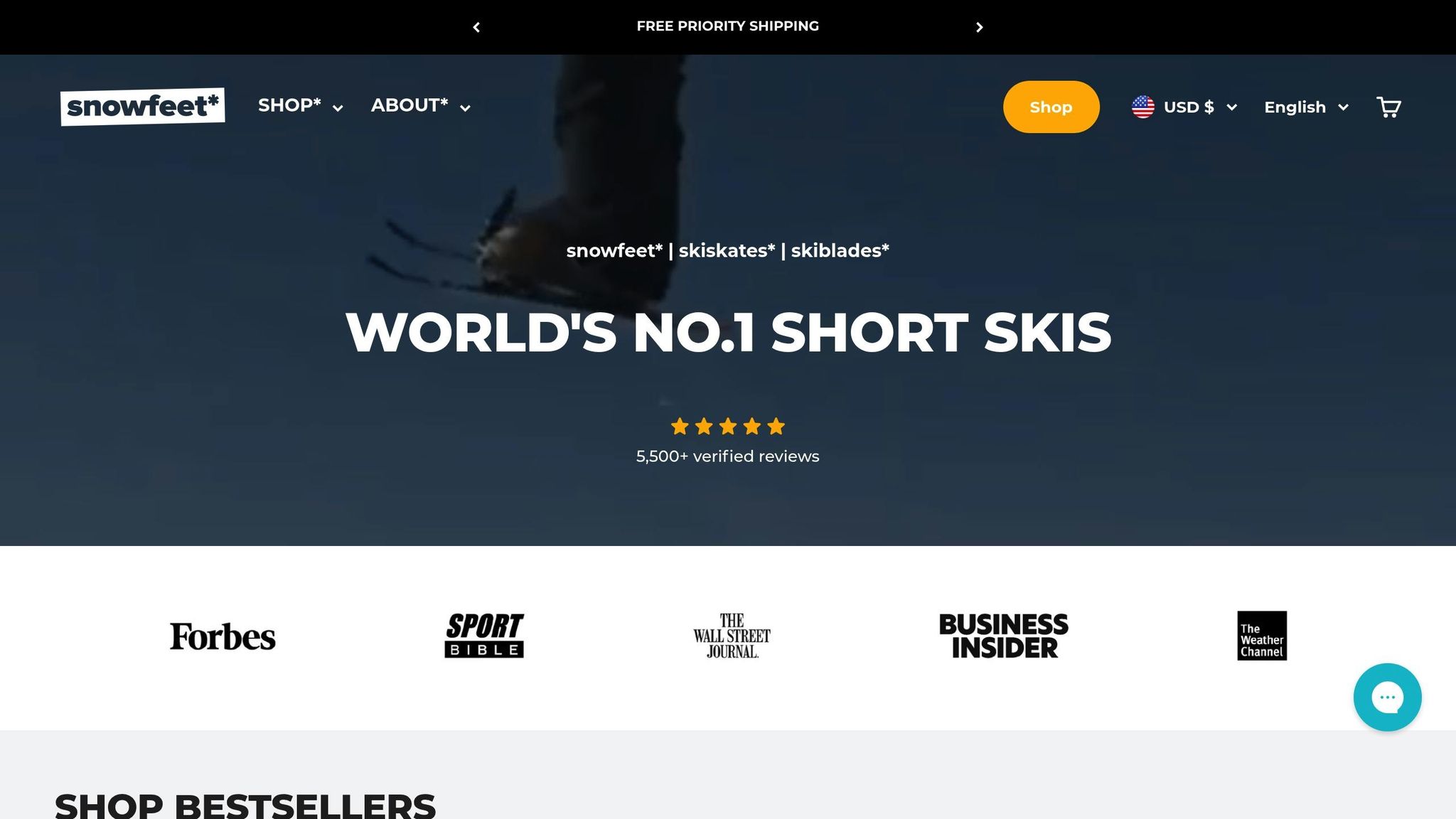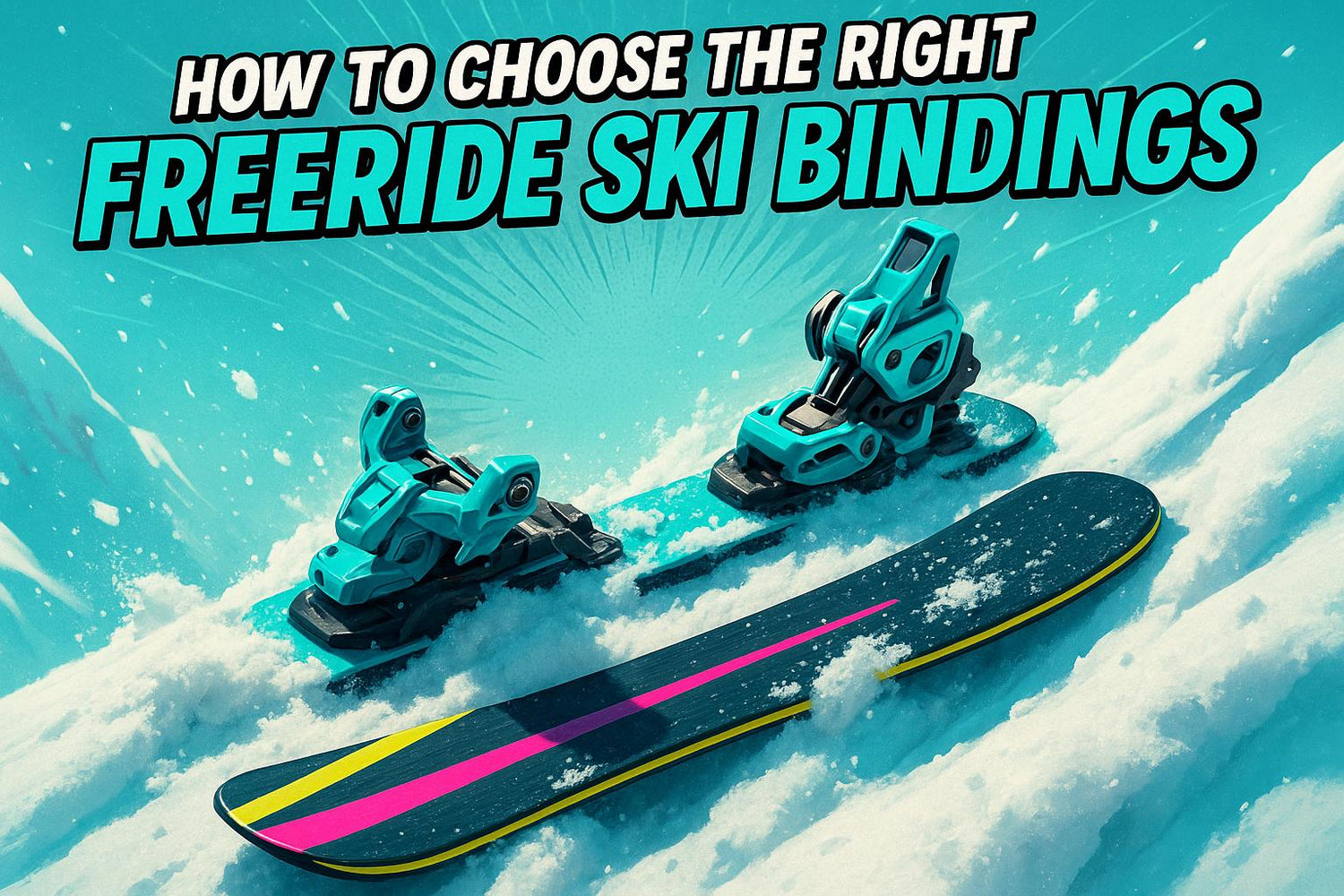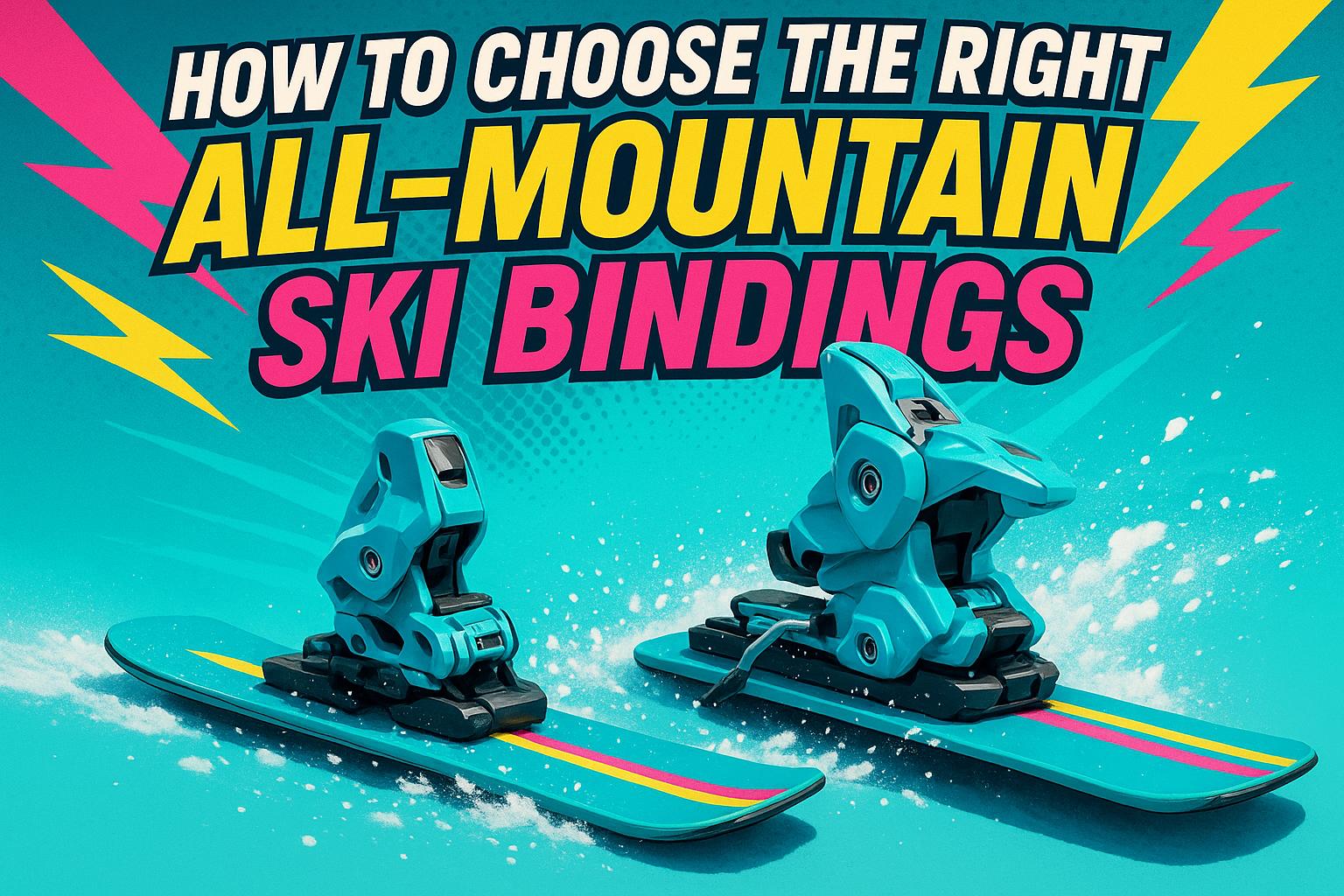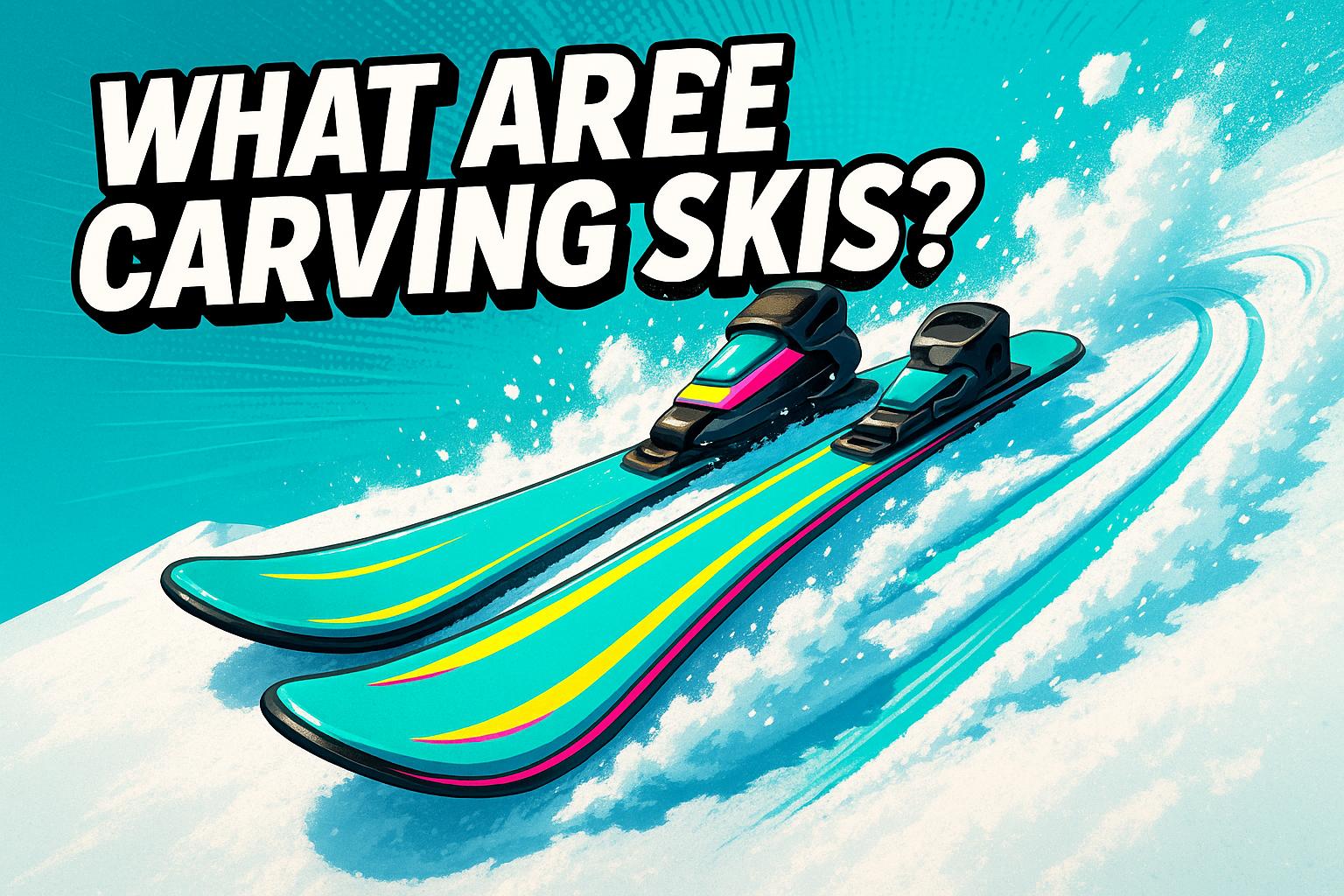フリーライドスキーでは、適切なビンディングが体験を左右します。ビンディングはブーツとスキーをつなぐ重要な役割を果たし、安全性、コントロール、パフォーマンスに大きく影響します。パウダーを切り裂き、ショートスキーでタイトなターンを決め、険しい地形に挑むときも、ビンディングはそれに応えなければなりません。知っておくべきことはこちらです:
- ショートスキーは精度が求められる:長いスキーとは異なり、SnowfeetのSkibladesやSkiskatesのようなショートスキーは、動きに即座に反応するビンディングが必要です。
- 安全第一:ビンディングは滑走中にブーツをしっかり固定し、転倒時には素早くリリースできなければなりません。
- タイプが重要:リリースビンディング(安全だが重い)とノンリリースビンディング(軽いがスキーレッシュが必要)のどちらかを選びましょう。
- DIN設定が鍵:最適な安全性のために、体重、スキルレベル、滑り方に合った正しいDIN範囲を選びましょう。
- 互換性が重要:ビンディングがブーツとスキーに合っていることを確認しましょう。例えば、Snowfeetのビンディングは、スキーブーツからスノーボードブーツまで様々なフットウェアに対応しています。
プロのコツ:ショートスキーで滑るなら、Snowfeetのビンディングは軽量でセットアップが簡単、機敏さと素早いターンに特化して設計されています。RossignolやAtomicのような重くて複雑なシステムの素晴らしい代替品です。
適切なフリーライドバインディングはパフォーマンスだけでなく、安全に楽しく滑るためのものです。詳細を見ていきましょう!
フリーライドスキーバインディングとは何か
フリーライドスキーバインディングの基本的な定義
フリーライドの スキーバインディング はオフピステスキーの知られざるヒーローです。ブーツをスキーにしっかりと固定し、動きをパワーに変換し、険しい地形を攻略する際の安定性を確保します。しかしここがポイントです - 必要に応じてリリースするように設計されており、予期せぬ転倒や衝撃時の怪我のリスクを減らします。
Rossignol や Atomic のような伝統的なリゾートスキーに使われるバインディングとは異なり、フリーライドバインディングはオフピステスキーの荒々しく予測不可能な条件を考慮して作られています。岩場、隠れた切り株、突然の落下などを想像してください。これらのバインディングはより頑丈で耐久性がありますが、その代わりに重くなっています。
多くの現代的なフリーライドバインディングの際立った特徴の一つは「ウォークモード」の搭載です。これによりバインディングを回転させることができ、登り坂の効率が向上します。フリーライドスキーとツアーを組み合わせる人に最適です。もう一つの重要な安全機能はスキーブレーキシステムで、リリース後にスキーが滑り落ちるのを防ぎます。プロのアドバイス:スキーブレーキはスキーのセンター幅より少し広めに設定すると最高のパフォーマンスが得られます。
"適切なスキーバインディングは、他の冬のスポーツ競技よりもフリーライディングにおいてさらに重要です。" - INTERSPORT Rent
では、これらのバインディングが短いスキーと組み合わせたときにどのように機能するか見てみましょう。
短いスキーにおけるバインディング選びが重要な理由
短いスキーに関しては、選ぶバインディングは重要というだけでなく、非常に重要です。Snowfeet* Skiblades や Skiskates のような短いスキーは、長いスキーとは異なる反応を示します。ブーツでのわずかな動きがスキーの反応に直接影響します。つまり、正確で即時のフィードバックを提供し、接続感を鈍らせないバインディングが必要です。
Snowfeet* バインディングはこれを念頭に置いて設計されています。Head や Elan のように長いスキーのパフォーマンスに焦点を当てるブランドとは異なり、Snowfeet* は短いスキーに特化したバインディングを作り出しました。リリースタイプと非リリースタイプの両方のバインディングオプションを提供し、あなたのスキーのスタイルや安全性のニーズに合わせて柔軟に選べます。
Snowfeet*のバインディングの最もクールな点の一つ?それはスキーブーツだけでなく、さまざまな靴に対応していることです。バインディングの種類によっては、普通の冬用シューズ、スノーボードブーツ、または伝統的なスキーブーツを使うことができます。この多様性がショートスキーの新しい可能性の世界を開きます。
ショートスキーは機敏さと素早いターンがすべてであり、適切なバインディングが大きな違いを生みます。Snowfeet*のバインディングは軽量を保ちながらしっかりとした接続を確保し、コーナーを素早く回り込み、狭い場所も楽にナビゲートできます。
もう一つのボーナス?Snowfeet*のバインディングのセットアップはとても簡単です。従来のフリーライドバインディングは専門的な取り付けや細かい調整が必要なことが多いですが、Snowfeet*のバインディングはより速くゲレンデに出られるよう設計されています。そして、Snowfeet*製品でよく使われる非リリースバインディングを使用する場合は、安全のためにスキーレッシュを忘れずに使いましょう。これは利便性とリスク管理のバランスを取るシンプルで効果的な方法で、より自由に滑走を楽しめます。
スキーバインディングの選び方
フリーライドスキーバインディングの主なタイプ
フリーライドスキーバインディングにはさまざまなスタイルがあり、それぞれ特定の強みと妥協点を持っています。特に短いスキーを使う場合、小さな違いがパフォーマンスと安全性に大きな影響を与えるため、適切なものを選ぶことが重要です。
アルパインバインディング
アルパインバインディングは確かなパワー伝達と信頼できる安全機能で知られています。正確なコントロールを提供するよう設計されていますが、重くなりがちでツーリングには適していません。RossignolやAtomicのようなブランドはこれらのバインディングを長いスキー用に設計することが多く、短いスキーで必要な素早く機敏な動きにはあまり効果的ではありません。さまざまなブーツタイプに合うバインディングをお探しなら、GripWalkやMulti-Normの選択肢を検討する価値があります。
GripWalkとMulti-Normバインディング
GripWalkバインディングは快適さと実用性を重視しています。特に氷の上での歩行時に優れたグリップを提供し、GripWalkソールとアルパインソールの両方にシームレスに対応し、安全性を犠牲にせず柔軟性をもたらします。Multi-Norm Certified (MNC) バインディングはさらに多用途性を高めています。調整可能なつま先の高さにより、さまざまなブーツソールに対応可能です。ただし、HeadやElanなどの伝統的なアルパインバインディングはアルパインソールに限定されます。
調整可能でユニバーサルなバインディング
何か新しいものを求める方のために、Snowfeet*はバインディングのデザインを再考しました。従来の調整可能なバインディングは可動部品のために余分な重量と複雑さを加えることが多いですが、Snowfeet*のユニバーサルバインディングはシンプルにしています。これらのバインディングは冬用シューズ、スノーボードブーツ、またはスキーブーツに対応し、軽量でシンプルなソリューションを提供します。
"SkiskatesとSkiboardsには、非リリーススキービンディングが答えです。手頃で安全な選択肢です。" - Snowfeet*のアンナ
Snowfeet*はスキーボード用に特別設計されたスノーボードビンディングも提供しています。これらのビンディングは調整可能で軽量、さらに他のオプションに比べてコストパフォーマンスにも優れています。安全性とコスト面で、主に2種類のビンディングから選べます:
- リリースビンディング:安全性を高めるリリース機構が含まれていますが、重く価格も高めです。
- 非リリースビンディング:軽量で手頃な価格ですが、安全のためにスキーレッシュの使用が必要です。
選択は、あなたにとって何が最も重要か—安全性、重量、予算—によって変わります。各オプションは異なるスキーのスタイルやニーズに合わせた独自の特徴を提供します。
パフォーマンス機能と安全メカニズム
フリーライドビンディングは、安全性とパフォーマンスを高めるための機能が満載です。これらのメカニズムは連携して、特に激しいスキーセッション中にあなたをしっかりと守りつつ、反応性を向上させます。これらが揃うことで、スキーセットアップが完成し、すべての滑走がコントロールされ安全に感じられます。
DIN範囲:あなたに合った適切な設定を見つける
DIN(Deutsches Institut für Normung)設定はスキーの安全性において重要な要素です。これは転倒時にビンディングがリリースされるために必要な力の量を決定します。設定が高すぎると、必要な時にビンディングがリリースされず、怪我のリスクが高まります。逆に低すぎると、予期せずリリースされてバランスを崩す可能性があります。
DIN設定は、体重、身長、ブーツのソール長、年齢、スキーのスタイルなど複数の要素の組み合わせによって決まります。まずは自分のスキーヤータイプを特定することから始まります:
- タイプ1:ゆっくりとした速度と簡単な地形を好む慎重なスキーヤー。
- タイプ2:さまざまな速度や地形を楽しむスキーヤー。
- タイプ3:高速かつ難易度の高い斜面に挑む攻撃的なスキーヤー。
こちらは簡単な参考表です:
| スキーヤーの体重 | 初心者DIN | 中級者DIN | 上級者/エキスパートDIN |
|---|---|---|---|
| 92 - 107 lbs | 3 | 3.7 | 4.5 |
| 108 - 125 lbs | 3.7 | 4.5 | 5.5 |
| 126 - 147 lbs | 4.5 | 5.5 | 6.5 |
| 148 - 174 lbs | 5.5 | 6.5 | 7.5 |
| 175 - 209 lbs | 6.5 | 7.5 | 9 |
| 209ポンド以上 | 7.5 | 9 | 10.5 |
年齢も重要な要素です。10歳未満や50歳以上のスキーヤーは、安全性を高めるために通常より低いDIN設定が必要です。一方、経験豊富または体重の重いスキーヤーは、攻撃的なスタイルに合わせてより高い設定が求められることが多いです。
適切なDIN値を得るには、必ず認定技術者に相談してください。推測は禁物です—これは安全とスキー性能を確保するために重要な部分です。RossignolやAtomicのようなブランドは通常、専門的な取り付けと調整を推奨しており、これが全体のコストに加わることがあります。次に、弾力性がこれらの設定を補完し、さらに良いパフォーマンスをもたらす方法を見ていきましょう。
弾力性と衝撃吸収
ビンディングの弾力性とは、リリース前にしなりや衝撃吸収ができる能力を指します。この機能は急な動きや衝撃時のコントロール維持に不可欠です。弾力性が高いほど、ビンディングは衝撃を吸収し元の位置に戻ることができます。
Snowfeet* Skibladesのような短いスキーでは、弾力性が特に重要です。これらのスキーは素早い動きや方向転換に敏感であり、ビンディングは安全性を損なわずにそれに対応する必要があります。HeadやElanのような従来のアルペンビンディングは通常、長いスキーを想定して設計されているため、短いスキーの素早い動きにはあまり適していません。
Snowfeet*は短いスキー専用にビンディングを設計することでこの課題に対応しました。内蔵システムはしっかりとした接続と優れた衝撃吸収を提供し、従来のセットアップで必要とされる複雑な取り付けや互換性調整を不要にします。
ブレーキ幅と互換性
ビンディングブレーキとは、スキーから外れたときに飛び出して雪に食い込むアームのことです。役割は?スキーが滑り去るのを防ぐことです。ブレーキの幅を正しく選ぶことが重要です。狭すぎると十分な制動力が得られません。
ちょっとしたコツ:スキーのウエスト幅より5〜15ミリ広いブレーキを選びましょう。例えば、スキーのウエストが88mmなら、93mmから103mmの幅のビンディングブレーキを探してください。スキーに合わないブレーキを使うと、雪との接触が不十分になり安全上の問題が生じる可能性があります。
Snowfeet*製品はこのプロセスをシームレスにします。彼らのSkibladesとSkiskatesにはビンディングが内蔵されており、手動調整や互換性の心配が不要です。一方、AtomicやElanなどの従来のシステムは、ビンディングの仕様を特定のスキーに慎重に合わせる必要があり、セットアップに余分な手順が加わります。
sbb-itb-17ade95
Snowfeet* ビンディング vs 従来のスキーブランド

Rossignol、Atomic、Head、Elanなどの従来のスキーブランドのビンディングは長いスキーに合わせて作られており、専門的な取り付けや正確な調整が必要なことが多いです。一方、Snowfeet*は新しいアプローチを採用し、使いやすさ、携帯性、柔軟性を優先しています。目標は?より早く、より手間なくゲレンデに立つことです。
Snowfeet*の違いは何ですか?
Snowfeet*が従来のビンディングと比べてどのように際立っているかを簡単にご紹介します:
| 特徴 | Snowfeet*の特徴 | 従来のバインディング |
|---|---|---|
| セットアップ | 迅速かつ簡単で、専門的な設置は不要 | 専門的な取り付けと調整が必要 |
| 携帯性 | バックパックに入るほど小型 | かさばり、スキーバッグやルーフラックが必要なことが多い |
| フットウェアの互換性 | 通常の冬用ブーツで使用可能 | 専門のスキーブーツが必要 |
| 多用途性 | さまざまな冬のアクティビティに適応 | 主に標準的なスキー技術向けに設計 |
Snowfeet*のバインディングは、利便性と多用途性を重視する方に最適です。専門的なギアや技術的なセットアップが不要で、都会のスキーからバックカントリーの冒険、ゲレンデでのカジュアルな滑走まで幅広く対応します。雪が降った後の街中の散策や山へのお出かけでも、Snowfeet*はシンプルさを保ち、冬のスポーツを楽しむ新しい方法を広げてくれます。
正しいフリーライドバインディングの選び方
フリーライドバインディングを選ぶのは、見かけた最初のペアを掴むだけではありません。スキルの適合、互換性、耐久性の適切なバランスを見つけて、ゲレンデでのニーズに合ったものを選ぶことが大切です。
あなたのスキルレベルとスキーのスタイルに合わせよう
バインディングを選ぶ際には、あなたのスキルレベルが大きな役割を果たします。初心者の場合は、DIN設定が3–6のバインディングを選ぶと良いでしょう。一方、上級者やアグレッシブなスキーヤーは、特にジャンプに挑戦したり、ハードにカービングしたり、難しい地形を滑る場合は、8–12以上の範囲の設定を探すべきです。DIN設定が高いほど衝撃吸収性も向上し、激しいライディングをこなすための重要なポイントとなります。
Snowfeet*のようなバインディングは多用途で際立っています。整備されたトレイルからパウダーボウル、さらにはテレインパークまで対応可能で、RossignolやAtomicのようなブランドで見られる専門的なセットアップは不要です。ただし、始める前にバインディングが他のギアと適合しているか必ず確認してください。
まず互換性をチェックしましょう
バインディングをスキーのスタイルに合わせたら、次はブーツとスキーとの互換性を確認することが重要です。例えば、HeadやElanのような伝統的なスキーバインディングは特定のスキーブーツを必要としますが、Snowfeet*のバインディングはスキーブーツ、スノーボードブーツ、さらには冬用ブーツまで幅広い履物に対応し、セットアップが簡単です。
もう一つ重要なポイントはブレーキ幅です。スキーがリリースされる際に適切に機能するよう、ブレーキ幅がスキーのウエスト幅から15mm以内であることを確認してください。
"SkiskatesとSkiboardsには非リリーススキーバインディングが答えです。手頃で安全な選択肢です。" – Snowfeet*のAnna
取り付け互換性も重要です。Snowfeet*のSkibladesやSkiskatesのようなショートスキーは、簡単なセットアップと最適なパフォーマンスのために特別に設計された取り付けシステムを備えており、従来のシステムよりも手間がかかりません。
リリースバインディングと非リリースバインディングのどちらにするか決める際は、優先事項を考慮してください。リリースバインディングは安全機構が内蔵されており、着脱が簡単ですが、重くて高価です。一方、非リリースバインディングは軽量で安価、調整可能ですが、ブレーキがないためスキーレッシュが必要です。
耐久性と価値を重視しましょう
フリーライドバインディングに投資するなら耐久性は必須です。プラスチックではなく、高応力部位に金属部品を使用したバインディングを選びましょう。Marker Griffon 13やLook Pivot 15 GWのようなモデルは耐久性で知られていますが、取り付け費用を考慮すると価格は高めです。
良いバインディングはブーツとスキーのしっかりとした接続を保証し、ターンやジャンプ時のエネルギーロスを最小限に抑えます。例えば、Snowfeet*のバインディングは効率的なパワートランスファーを実現しつつ、幅広いユーザーに使いやすい設計です。
安全機能も同様に重要です。高い弾性(約1.8インチまたは45mmのエラストリックトラベル)と適切な横方向リリース機構を備えたバインディングを探しましょう。摩擦防止装置もプラス要素で、制御された動きを可能にし、必要に応じてリリースすることで怪我のリスクを減らします。
最後に、全体的な価値を考えましょう。AtomicやRossignolなどのブランドの従来のビンディングは$230–$430に取り付け料金が加わることがありますが、Snowfeet*ビンディングは多くの追加費用を省きつつ、フリーライド愛好者に信頼できるパフォーマンスを提供します。
DIN設定を選ぶ際は、現在のスキルレベルに合い、成長の余地がある範囲を選んでください。迷ったら、パフォーマンスと安全性の両方を考慮して設定を微調整できる専門のスキーテクニシャンに相談しましょう。
適切なビンディングでパフォーマンスを向上させましょう
適切なビンディングはスキー体験に大きな違いをもたらします。単にブーツを固定するだけでなく、コントロール、安全性、そして全体的な楽しさを向上させます。ブーツとスキーの間の強く信頼できる接続は、フレッシュパウダーを滑る時も鋭く正確なターンをする時も、すべての動きをスムーズに伝えます。Snowfeet*ビンディングはこの点で優れており、素早い動きやトリックに最適な安全で柔軟な接続を提供します。このコントロールと適応性の組み合わせが、より滑らかで楽しいライドを実現します。
もう一つの大きな利点は快適さです。従来のビンディングは専門的な取り付けや調整が必要なことが多いですが、Snowfeet*ビンディングは自宅で簡単に調整できるよう設計されています。これにより時間を節約でき、コストも削減できるため、自分のニーズに合わせてセットアップを簡単に調整できます。
そして多様性もあります。Snowfeet*ビンディングはスキーブーツ、スノーボードブーツ、さらには冬用ブーツなど、さまざまなフットウェアに対応しています。つまり、新しいギアに投資することなくスタイルを変えられます。さらに、スノーボードスタイルのビンディングデザインはサーフィンのような感覚を加え、鋭いターンやトリックに必要な機敏さと精度をもたらします。横方向の動きが可能なのは画期的で、アグレッシブなライディング中のコントロールを高めつつ、ブーツをしっかり固定します。
パフォーマンスと快適さに加え、Snowfeet*ビンディングは耐久性と価値の面でも優れています。ベーシック、スタンダード、プロXの3つのオプションがあり、ニーズに合ったレベルを選べます。例えば、プロXモデルは最も耐久性が高く調整可能で、従来のビンディングの複雑さや高コストなしにトップクラスのパフォーマンスを提供します。
Snowfeet*ビンディングは単なる製品ではなく、より良く、より適応力のあるスロープの楽しみ方を提供します。
よくある質問
リリース式と非リリース式のフリーライドスキービンディングを選ぶ際に考慮すべきことは何ですか?
リリース式と非リリース式のフリーライドスキービンディングを選ぶ際には、安全性、パフォーマンス、そしてあなたのスキーの好みがすべての決め手となります。
リリースビンディングは転倒時に外れるように設計されており、怪我のリスクを減らします。特にタフな地形やSnowfeetのような短いスキーでのフリーライドに最適な選択肢です。安全性を高めるだけでなく、スキーの自然なフレックスを可能にし、より良いコントロールとパフォーマンスを実現します。
一方で、非リリースビンディングはシンプルで頑丈、そしてコストも抑えられます。しかし、落下時にリリースしないため怪我のリスクが高まる可能性があり、スキーの自然なフレックスを制限することもあります。このタイプを選ぶ場合は、安全リーシュが必須です。
ほとんどのフリーライドスキーヤー、特にSnowfeetのような短いスキーを使う人にとって、リリースビンディングは賢い選択です。より安全で適応性の高いセットアップを提供します。
体重とスキーのスタイルに基づいて、フリーライドスキービンディングの適切なDIN設定をどうやって見つければいいですか?
フリーライドスキービンディングの適切なDIN設定を決めるには、いくつかの重要な要素を考慮する必要があります:あなたの体重、身長、年齢、スキー技術、ブーツのソール長です。これらの情報が組み合わさって、ビンディングがリリースする力の強さを決定し、安全性とパフォーマンスのバランスを取ります。
ほとんどのフリーライドスキーヤーのDIN設定は通常2から10の間ですが、ただの推測は避け、信頼できるDINチャートや計算機を使って正確に設定しましょう。さらに良いのは、プロに調整してもらい、パウダーを滑るときも急斜面のテクニカルなラインを攻めるときも、あなたのスキーのスタイルに合った設定にすることです。適切な設定は怪我の防止だけでなく、山でのコントロールと自信も高めます。
Snowfeetのビンディングは、従来のスキービンディングと比べてなぜ短いスキーに適しているのでしょうか?
Snowfeetのビンディングは短いスキー専用に作られており、軽量でコンパクトなオプションを提供し、コントロールとパフォーマンスの両方を向上させます。RossignolやAtomicのような大手ブランドの従来のビンディングは長いスキー用に設計されていますが、Snowfeetのビンディングはシンプルさと使いやすさに重点を置いており、スキーブレード、Skiskates、その他のコンパクトスキーでのフリーライドに最適な選択肢です。
これらのビンディングは、特に狭い場所や精密さが求められる場面で、より優れた操作性と柔軟性を提供します。超初心者にも優しく、メンテナンスも簡単なので、カジュアルスキーヤーにとって手間のかからない選択肢です。整備されたトレイルを滑るときも、フリーライドの地形に挑むときも、Snowfeetのビンディングは従来のビンディングにはない利便性と多様性をもたらします。


































コメントを残す
このサイトはhCaptchaによって保護されており、hCaptchaプライバシーポリシーおよび利用規約が適用されます。